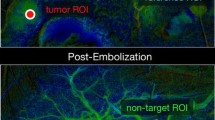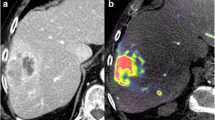Abstract
Objectives
To study feasibility and validity of a new software application for intraprocedural assessment of perfusion during chemoembolisation of melanoma metastases.
Methodology
In a prospective phase-II trial, ten melanoma patients with liver-only metastases underwent chemoembolisation with doxorubicin-eluting beads (DEBDOX-TACE). Tumour perfusion was evaluated immediately before and after treatment at cone beam computer tomography (CBCT) using a new software application. For control and comparison, patients underwent perfusion measurement via contrast-enhanced multidetector CT (MDCT) before and after treatment.
Results
CBCT showed 94.7 % reduction in perfusion in metastases after DEBDOX-TACE, whereas MDCT showed 96.8 %. Reduction in perfusion after treatment was statistically significant (p < 0.01) for both methods. The additional time needed for data acquisition during treatment was 5 min per case or less; the post-processing data analysis was 10 min or less. Perfusion imaging was associated with additional contrast agent and patient exposure to radiation (dose-length product [DLP]): 18 ml and 394 mGy*cm in CBCT and 100 ml and 446 mGy*cm in MDCT, respectively.
Conclusions
Reduction in perfusion of melanoma metastases after DEBDOX-TACE can be reliably assessed during the intervention via perfusion software at CBCT. Data acquisition and analysis require additional time but can be easily performed during the treatment.
Key Points
• Tumour perfusion of melanoma metastases can be assessed at cone beam CT.
• The software shows a significant decrease of tumour perfusion after DEBDOX-TACE.
• Data acquisition and analysis require an acceptable additional time during the procedure.
• CBCT requires less radiation exposure and contrast for perfusion study than MSCT.
• This software can monitor the course of DEBDOX-TACE in melanoma metastases.




Similar content being viewed by others
Abbreviations
- (c)TACE:
-
(conventional) Transarterial chemoembolisation
- CBCT:
-
Cone beam computed tomography (synonym: C-arm CT)
- DEB:
-
Drug-eluting beads
- DOX:
-
Doxorubicin
- HPI:
-
Hepatic Perfusion Index
- MDCT:
-
Multidetector computed tomography (synonym Multislice-CT)
- MM:
-
Malignant melanoma
- PBV:
-
Parenchymal blood volume
References
Virgili G, Gatta G, Ciccolallo L et al (2007) EUROCARE Working Group. Incidence of uveal melanoma in Europe. Ophthalmology 114:2309–2315
Sato T (2010) Lokoregional management of hepatic metastasis from primary uveal melanoma. Semin Oncol 37:127–138
Shields CL, Shields JA (2009) Ocular melanoma: relatively rare but requiring respect. Clin Dermatol Jan-Feb 27:122–133
Eschelman DJ, Gonsalves CF, Sato T (2013) Transhepatic therapies for metastatic uveal melanoma. Semin Intervent Radiol 30:39–48
Lammer J, Malagari K, Vogl T et al (2010) PRECISION V Investigators. Prospective randomized study of doxorubicin-eluting bead embolization in the treatment of hepatocellular carcinoma: results of the PRECISION V study. Cardiovasc Intervent Radiol 33:41–52
Varela M, Real MI, Burrel M et al (2007) Chemoembolisation of hepatocellular carcinoma with drug eluting beads: efficacy and doxorubicin pharmacokinetics. J Hepatol 46:474–481
Brown RE, Gibler KM, Metzger T et al (2011) Image guided transarterial chemoembolization with drug-eluting beads loaded with doxorubicin (DEBDOX) for hepatic metastases from melanoma: early outcomes from a multi-institutional registry. Am Surg 77:93–98
Marelli L, Stigliano R, Triantos C et al (2007) Transarterial therapy for hepatocellular carcinoma: which technique is more effective? A systematic review of cohort and randomized studies. Cardiovasc Interv Radiol 30:6–25
Lewis AL, Taylor RR, Hall B, Gonzalez MV, Willis SL, Stratford PW (2006) Pharmacokinetic and safety study of drug-eluting beads in a porcine model of hepatic arterial embolization. J Vasc Interv Radiol 17:1335–1343
Hong K, Khwaja A, Liapi E, Torbenson MS, Georgiades CS, Geschwind JF (2006) New intra-arterial drug delivery system for the treatment of liver cancer: preclinical assessment in a rabbit model of liver cancer. Clin Cancer Res 12:2563–2567
Poon RT, Tso WK, Pang RW et al (2007) A phase I/II trial of chemoembolization for hepatocellular carcinoma using a novel intra-arterial drug-eluting bead. Clin Gastroenterol Hepatol 5:1100–1108
Struffert T, Deuerling-Zheng Y, Kloska S et al (2011) Cerebral blood volume imaging by flat detector computed tomography in comparison to conventional multislice perfusion CT. Eur Radiol 21:882–889
Struffert T, Deuerling-Zheng Y, Kloska S et al (2010) Flat detector-CT in the evaluation of brain parenchyma, intracranial vasculature, and cerebral blood volume: a pilot study in patients with acute symptoms of cerebral ischemia. Am J Neuroradiol 31:1462–1469
Ahmed AS, Zellerhoff M, Strother CM et al (2009) C-arm CT measurement of cerebral blood flow volume: an experimental study in canines. Am J Neuroradiol 30:917–922
Van der Bom IM, Mehra M, Walvick RP, Chueh JY, Gounis MJ (2012) Quantitative evaluation of C-arm CT cerebral blood volume in a canine model of ischemic stroke. Am J Neuroradiol 33:353–358
Tomandl BF, Klotz E, Handschu R et al (2003) Comprehensive imaging of ischemic stroke with multisection CT. Radiographics 23:565–592
Spira D, Schulze M, Sauter A et al (2012) Volume perfusion-CT of the liver: insights and applications. Eur J Radiol 81:1471–1478
Miles KA, Hayball M, Dixon AK (1991) Colour perfusion imaging: a new application of computed tomography. Lancet 337:643–645
Royalty K, Manhart M, Pulfer K et al (2013) C-arm CT measurements of cerebral blood volume and cerebral blood flow using a novel high-speed acquisition and a single intravenous contrast injection. Am J Neuroradiol 34:2131–2138
Ippolito D, Capraro C, Casiraghi C, Sironi S (2012) Quantitative assessment of tumor associated neovascularisation in patients with liver cirrhosis and hepatocellular carcinoma: role of dynamic-CT perfusion imaging. Eur Radiol 22:803–811
Pandharipande PV, Krinsky GA, Rusinek H, Lee VS (2005) Perfusion imaging of the liver: current challenges and future goals. Radiology 234:661–673
Sahani DV, Holalkere NS, Mueller PR, Zhu AX (2007) Advanced hepatocellular carcinoma: CT perfusion of liver and tumor tissue - initial experience. Radiology 243:736–743
Tsushima Y, Endo K (2005) Portal perfusion measurement on dynamic CT in patients with liver cirrhosis. Am J Roentgenol 185:813
Van Beers BE, Leconte I, Materne R, Smith AM, Jamart J, Horsmans Y (2011) Hepatic perfusion parameters in chronic liver disease: dynamic CT measurements correlated with disease severity. Am J Roentgenol 176:667–673
Zhuang Z, Zhang XB, Han JF et al (2014) Hepatic blood volume imaging with the use of flat-detector CT perfusion in the angiography suite: comparison with results of conventional multislice CT perfusion. J Vasc Interv Radiol 25:739–746
Peynircioglu B, Hizal M, Cil B et al (2015) Quantitative liver tumor blood volume measurements by a C-arm CT post-processing software before and after hepatic arterial embolization therapy: comparison with MDCT perfusion. Diagn Interv Radiol 21:71–77
Vogl TJ, Schaefer P, Lehnert T et al (2015) Intraprocedural blood volume measurement using C-arm CT as a predictor for treatment response of malignant liver tumours undergoing repetitive transarterial chemoembolization (TACE). Eur Radiol 26:755–763
Miyayama S, Yamashiro M, Hashimoto M et al (2013) Identification of small hepatocellular carcinoma and tumor-feeding branches with cone-beam CT guidance technology during transcatheter arterial chemoembolization. J Vasc Interv Radiol 24:501–508
Wallace MJ, Murthy R, Kamat PR et al (2007) Impact of C-arm CT on hepatic arterial interventions for hepatic malignancies. J Vasc Interv Radiol 18:1500–1507
Kothary N, Abdelmaksoud MH, Tognoloni A et al (2011) Imaging guidance with C-arm CT: prospective evaluation of its impact on patient radiation exposure during transhepatic arterial chemoembolization. J Vasc Interv Radiol 22:1535–1543
Schernthaner R, Chapiro J, Sahu S et al (2015) Feasibility of a modified cone-beam CT rotation trajectory to improve liver periphery visualization during transarterial chemoembolization. Radiology 277:833–841
Schernthaner RE, Duran R, Chapiro J, Wang Z, Geschwind JF, Lin M (2015) A new angiographic imaging platform reduces radiation exposure for patients with liver cancer treated with transarterial chemoembolization. Eur Radiol. 25:3255–3262
Funding
This study has received funding by Siemens Healthlineers Germany; drug-eluting beads were provided by BTG Biocompatibles UK.
Author information
Authors and Affiliations
Corresponding author
Ethics declarations
Guarantor
The scientific guarantor of this publication is Philippe L Pereira.
Conflict of interest
The authors of this manuscript declare relationships with the following companies: A grant was received for cooperation on Interventional Oncology with Siemens Medical Solutions, which provides software and hardware for this study. PLP has received honoraria from BTG for advisory boards and conferences.
Statistics and biometry
One of the authors (KK) has significant statistical expertise.
Informed consent
Written informed consent was obtained from all subjects (patients) in this study.
Methodology
• prospective
• case-control study
• performed at one institution
Electronic supplementary material
ESM 1
(DOCX 40 kb)
Rights and permissions
About this article
Cite this article
Pereira, P.L., Krüger, K., Hohenstein, E. et al. Intraprocedural 3D perfusion measurement during chemoembolisation with doxorubicin-eluting beads in liver metastases of malignant melanoma. Eur Radiol 28, 1456–1464 (2018). https://doi.org/10.1007/s00330-017-5099-y
Received:
Revised:
Accepted:
Published:
Issue Date:
DOI: https://doi.org/10.1007/s00330-017-5099-y




